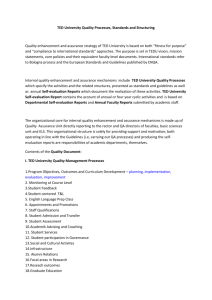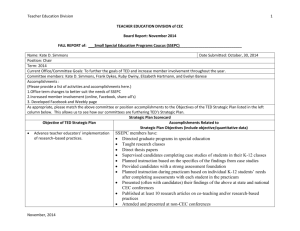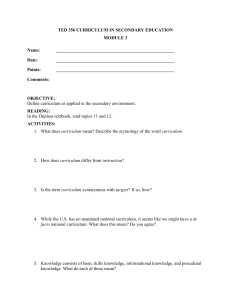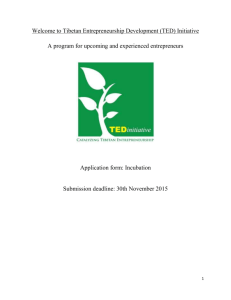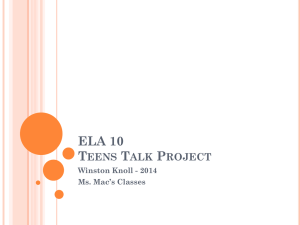File
advertisement
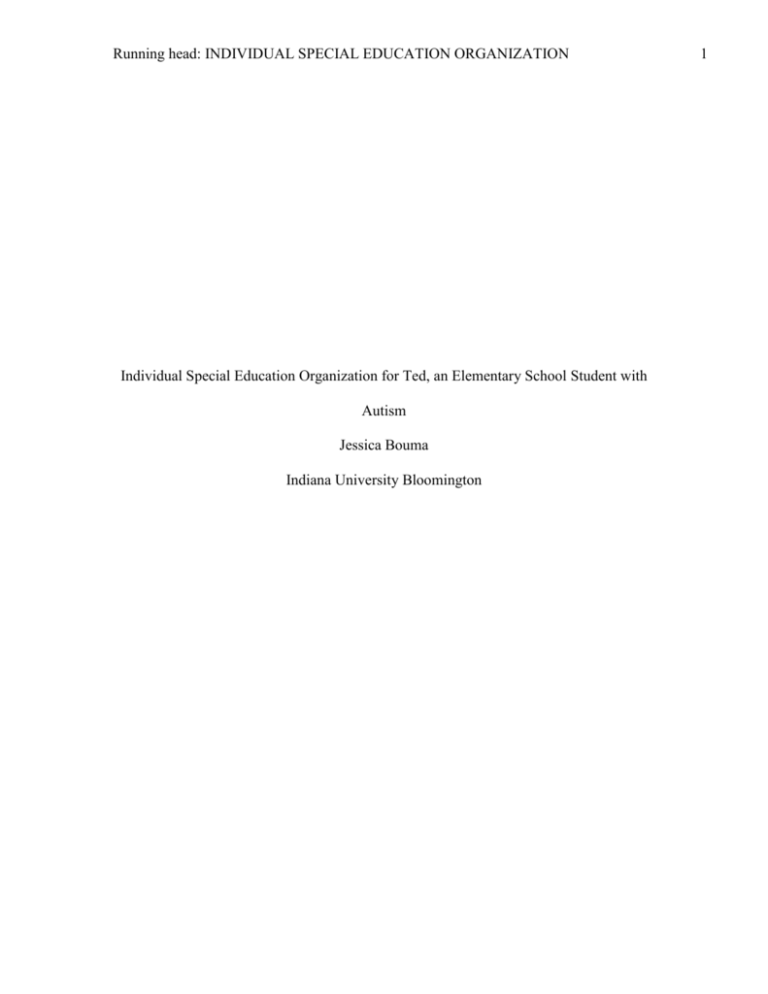
Running head: INDIVIDUAL SPECIAL EDUCATION ORGANIZATION Individual Special Education Organization for Ted, an Elementary School Student with Autism Jessica Bouma Indiana University Bloomington 1 INDIVIDUAL SPECIAL EDUCATION ORGANIZATION Abstract The purpose of this paper is to propose a hypothetical educational plan for a middle school individual, hereafter referred to as Ted. Ted was diagnosed with autism in third grade and is now entering fourth grade. Ted is very talented in memorizing dates and excels greatly in history and mathematics. He struggles with literature and science, often feeling overwhelmed when rules and strict step-by-step processes are replaced with openended responses. This paper will discuss the laws that guarantee an appropriate educational setting for Ted, including the Individuals with Disabilities Education Act (IDEA) and its subparts: Least Restrictive Environment (LRE) and Free Appropriate Public Education (FAPE). Using these laws, an appropriate educational setting will be suggested for Ted. The paper will also discuss why inclusion method suggestions such as Universal Learning Design (UDL) and ASD Nest are essential to suggest in Ted’s Individual Education Plan (IEP) meeting. 2 INDIVIDUAL SPECIAL EDUCATION ORGANIZATION Individual Special Education Organization for Ted, an Elementary School Student with Autism Special education laws, cases, and guidelines are not new concepts. In fact, the laws that we still apply today date back to 1973 with Section 504 (Valle and Connor, 2011). Since then, there have been so many students to go through schooling with IEP’s. Although IEP’s have become a regular and common part of education, it is often easy to forget that each IEP represents a child with unique and individual needs and not just another summation of laws for which to account. This individual quality of the IEP is important to recognize when discussing the subject of this paper, Ted. Ted is an incoming fourth grade student recently diagnosed with autism. He is extremely hardworking and motivated, exceling greatly in history and mathematics. He struggles with open-ended responses, such as literary analysis and explaining results to a project in science. Because of these struggles, he has received low marks in both literature and science. He also tends to have “episodes” when the flow of the classroom is disrupted, as in a fire drill or an unannounced guest in the classroom. Ted also complains at home of being lonely, because he has difficulty following social cues. Several of Ted’s teachers have suggested that he remain in a special education classroom due to his episodes especially. However, this paper will prove why Ted is entitled to an inclusive education if he and his family desire this type of setting. Under the Education for the Handicapped Act (now known as IDEA) of 1975, Ted is supported in federal law to receive special education services that fulfill the standards set by his IEP, as autism is one of the categories of disabilities protected under this act (Valle and Connor, 2011). If Ted’s parents disagree with the educational setting 3 INDIVIDUAL SPECIAL EDUCATION ORGANIZATION in which Ted is placed, they are protected to disagree and fight for a new plan under this act as well. IDEA has two large subcategories that will help guide Ted’s IEP team to his correct educational environment. The first subcategory that protects Ted is known as LRE. This act protects students by keeping them in an environment with other general education students when possible. The actual phrase used to describe the incorporation of students in the general classroom is “to the maximum extent appropriate” (Valle and Connor, 2011). The word appropriate has been difficult to define in multiple settings of special education. Going based off of the introduction of the paper, appropriate is an individual word that represents the child’s comfort levels and needs. Ted has described himself as most often being comfortable in the general education classroom other than a disruption from the normal setting. With some adaptations to make that aspect of the classroom feel comfortable for him, he would be more than able to participate in the general classroom on a behavioral level. Academically, he struggles with certain skillsets as stated before. With a little curriculum adaptation that will be introduced later, Ted will be able to maintain appropriate grades in all classes. With these slight changes, the environment that is maximum extent appropriate for Ted is in the general education classroom. According to the Hulett (2009) article on LRE, benefits in both academic and social areas are viewed in students who are placed in a more accurately defined LRE than those placed immediately in a special education classroom. In order to ensure that Ted is in his LRE after placing him in a general education classroom, the IEP team can use the checklist for educators when determining LRE for students with disabilities provided in the Hulett (2009) article. Along with a point about the student’s academic and other 4 INDIVIDUAL SPECIAL EDUCATION ORGANIZATION benefits, it also asks the team to identify effects on other students and steps the school has taken to ensure they are working to provide supplementary material for the IEP student if necessary. In addition to LRE, Ted is also supported in FAPE under the IDEA. Again, in FAPE, the word in question is ‘appropriate.’ Appropriate can not be defined for Ted unilaterally, but rather by a combination of people who make up his IEP team. According to the seventh chapter of the Hulett (2009) reading, the team must consider the general education classroom as a ground level beginning basis before moving into more restricted environments. If, after adaptations have been tried, Ted shows disruptive issues to himself or to others, then a new plan will be made to provide Ted with the most inclusive environment possible while maintaining a positive environment for all involved. Ted has shown some disruptive behaviors in the general education classroom. However, until this point, accommodations have not been attempted to assist Ted to control these disruptions. Some suggestions for adjustments will be discussed later in the paper. The Hulett (2009) article also addresses that academically, a good indicator of progress can be standardized test scores, and therefore can determine if an education setting is deemed appropriate. However, the article also suggests that there are many other ways of determining progress and the level of appropriateness of the setting. Although the Hulett article does not mention specific ideas, the Lingo et. al. (2009) article on teacher collaboration design discusses alternative plans to standardized testing. Some of these alternatives are based on teacher observations, such as a written journal on each student. As Ted does show low test scores in certain subjects, finding an additional 5 INDIVIDUAL SPECIAL EDUCATION ORGANIZATION way to measure his progress would be an ideal adaptation to provide for him in the general classroom. However, asking a teacher to keep a log of every student while trying to teach the class would be an impossible task to request. With the help of programs like ASD Nest and UDL incorporation, this task would be more than manageable. According to Koenig et. al. (2009), the ASD Nest program incorporates both students with autism and those without, in an effort for greater social interaction and learning between the two groups. This educational setting usually holds sixteen students in a class, four of which are students with autism. This model also includes a strategy called pair teaching (Koenig et. al., 2009). Pair teaching is a concept that involves multiple teachers who are specialized in different areas in the classroom. For ASD Nest programs, there are usually two or three teachers or helpers in the classroom at one time: one who is certified in general education, one certified in special education, and one optional cluster teacher who is able to work with children dealing with behavioral issues (Koenig et. al., 2009). This structure is exactly what Ted needs. The amount of teachers in the room will definitely allow for personal assessments to be taken for each student. Ted will also be able to receive more individualized attention if needed. The ASD Nest program focuses on UDL. In other words, all students are included and taken into account equally in the development of the curriculum. The whole premise of UDL is to give students more resources to choose from in order to learn through the use of a flexible and adaptable curriculum (Garderen and Whittaker, 2006). ASD Nest programs tailor to both students with and without autism, offering a curriculum that is flexible enough to provide an appropriate environment for both groups. These classes cover the same material as regular general education classes, but provide 6 INDIVIDUAL SPECIAL EDUCATION ORGANIZATION the material in different unique ways. For Ted, who struggles with open-ended questions, a modification on the original curriculum could involve guiding questions for an assignment. This way, Ted can follow each guiding question step-by-step to ensure that he has not missed any parts that the teacher is looking for. In addition to involving UDL, ASD Nest offers a multi-layer schedule structure. The daily class schedule is used as the umbrella model, while individual schedules are used based on the needs of each student. Both schedules are posted so students can know what to expect. This visible schedule will help with Ted’s need for order and consistency. However, to make sure Ted grows and is assisted out of his comfort zone, the schedule will include a question mark so students will expect a change, but it will be an unknown change. Eventually, Ted will grow accustomed to a change in the daily schedules (Koenig et. al., 2009). Although this paper mostly serves the purpose of finding a most appropriate fit for Ted, it is important to point out that all types of students will benefit from this ASD Nest type of program. As described in an article by McLeskey and Waldron (2007), inclusion is most effective when it is able to make a variety of differences ordinary. If the students involved in the ASD Nest program interact on a regular basis with students with autism, many of the discriminatory problems we face in everyday life will lessen greatly. The most significant benefit for general education students involved in this program is discussed in an article by Chandler-Olcott and Kluth (2009). Because students with autism sometimes require many different approaches to reach understanding of a concept, the students without autism are exposed to many different 7 INDIVIDUAL SPECIAL EDUCATION ORGANIZATION approaches as well. Students are also exposed to a variety of ways of participating in the classroom (Chandler-Olcott and Kluth, 2009). In conclusion, laws such as IDEA and its subparts (LRE and FAPE) support Ted in receiving the most appropriate education that his school can offer him. Regardless of the logistics of the laws, it is important to recognize that Ted is an individual with unique talents and needs. With certain modifications to curriculum through a program such as ASD Nest, Ted’s talents will be able to shine through and his needs will be fulfilled. In Ted’s initial IEP meeting, the ASD Nest program would be a great inclusive fit to consider for Ted. If this program is not a financial option in his school, Ted is supported by law to be allowed in the general classroom with accommodations. Just as a person is innocent until proven guilty, Ted has the right to be in the general types of classrooms with accommodations before he is removed. 8 INDIVIDUAL SPECIAL EDUCATION ORGANIZATION References Chandler-Olcott, K., & Kluth, P. (2009). Why Everyone Benefits From Including Students with Autism in Literacy Classrooms. The Reading Teacher, 62(7), 548557. Hulett, K. E. (2009). Legal Aspects of Special Education. Pearson. Koenig, K. P., Bleiweiss, J., Brennan, S., Cohen, S., & Siegel, D. E. (2009). The ASD Nest Program. Teaching Exceptional Children, 42(1), 6-13. Lingo, A. S., Barton-Arwood, S. M., & Jolivett, K. (2011). Teachers Working Together: Improving learning outcomes in the inclusive classroom – practical strategies and examples. Teaching Exceptional Children, 43(3), 6-13. McLeskey, J., & Waldron, N. L. (2007). Making Differences Ordinary in Inclusive Classrooms. Intervention in School and Clinic, 42(3), 162-168. Valle, J. W., & Connor, D. J. (2011). Rethinking Disability. New York: McGraw-Hill. van Garderen, D., & Whittaker, C. (2006). Planning Differentiated, Multicultural Instruction for Secondary Inclusive Classrooms. Teaching Exceptional Children, 38(3), 12-20. 9

